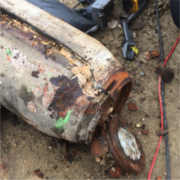The deflagration attempt on the blast site went according to plan: instead of a large detonation, the detonator popped out of the 500-pound bomb, the shell exploded along the predetermined notch and only a very small part of the explosive exploded. Thus, the end of the joint project of the Laser Zentrum Hannover e.V. (LZH), LASER on Demand GmbH and the Kampfmittelräumdienst Hamburg (KRD) is more than successful. The laser-based approach could provide more security for explosive ordnance disposal technicians in the future.
Laser-based deflagration: field-compatible and automated
The scientists at the LZH developed the process for automated deflagration in the DEFLAG project. In the first step, a notch is inserted into the bomb casing using a solid-state laser with two kilowatts of power. Thereafter, in the second step, the explosive is deflagrated in a controlled way. As the system technology is exposed to strong heat and pressure, the LZH and its spin-off company LASER on Demand GmbH have developed a low-cost, 3D-printed laser processing head with standard optical components. The handling of the ordnance and of the explosives in the field trials as well as the final field trial with the 500-pound bomb were carried out by the staff of the Kampfmittelräumdienst Hamburg.
この情報へのアクセスはメンバーに限定されています。ログインしてください。メンバー登録は下記リンクをクリックしてください。

